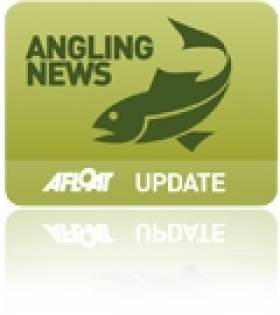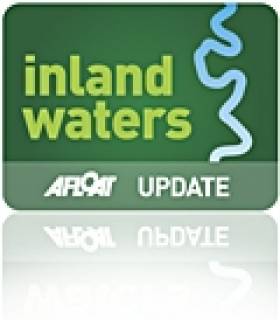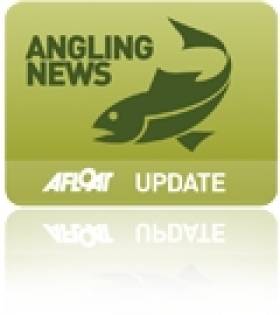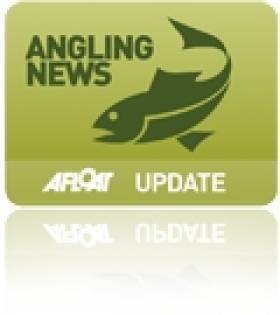Displaying items by tag: Inland Fisheries Ireland
New Fisheries Partnership for the River Shannon
The new group will comprise representatives from both bodies as well as Inland Fisheries Ireland, and will be independently chaired by former Shannon Fisheries Board CEO Eamon Cusack.
The plan is for anglers, fishery authorities and stakeholders to come together to assist in the management of the River Shannon.
At the group's launch in Athlone recently, Cusack said the partnership was working toward ensuring a sustainable yield of fish.
Atlantic Salmon on 'Red List' of Endangered Species
Atlantic salmon have joined four other native fish on a 'red list' of endangered species compiled by the Ireland's fisheries and wildlife agencies.
As the Irish Independent reports, one third of the State's 15 native fish species are considered endangered or vulnerable.
One of the worst hit is the European eel, which was found to be critically endangered.
In a report published yesterday, a number of threats were highlighted such as water pollution, invasive species, overfishing, poor river management and climate change.
According to The Irish Times, the Red List was compiled by scientists from organisations across the island including Inland Fisheries Ireland, the National Parks and Wildlife Service, the Northern Ireland Environment Agency and the National Biodiversity Data Centre.
The news comes just a few days after Dublin celebrated the return of wild Atlantic salmon to the River Tolka after more than a century.
The Irish Times has more on the story HERE.
Welcome Boon for the River Moy
The New York Times recently paid a visit to the River Moy in Co Sligo, where angling has experienced a resurgance in recent years.
Since the ban on drift netting off Irish shores in 2007, salmon numbers in the Moy have risen to 75,000 annually, according to Inland Fisheries Ireland.
It's a welcome boon for the River Moy, which also suffered the effects of dregding for agricultural purposes in the 1960s which "cripped much of the integrity of the river’s substrata away, creating the equivalent of a featureless canal through much of its course."
Weirs and spawning gravel in tributary streams have helped the Moy to recover some of its former glory, and the river now welcomes thousands of anglers each year - especially to the top spots in Ballina town centre.
The New York Times has more on the story HERE.
Fisheries Funding for Salmon Recovery Projects
Some 17 projects have been approved for funding under the Salmon Conservation Fund, The Irish Times reports.
The pilot scheme by Inland Fisheries Ireland is designed to help angling clubs and fishery owners restore salmon stocks in Ireland's rivers.
The successful applicants across 11 counties will receive a share from more than €120,000 derived from salmon licence-holder contributions.
Accepted projects include spawning enhancement, bank protection, fish passage and habitat improvement. Priority was given to rivers below conservation limits.
The Irish Times has more on the story HERE.
Nothing Fishy About Donard Pupils' Prizewinning Musical
Pupils at Donard National School fended off competition from across Ireland to win a coveted prize in the Inland Fisheries Ireland 'Something Fishy' competition for 2011, the New Ross Standard reports.
Wexford footballer Brian Malone presented fifth and sixth class pupils at Donard NS with goodie bags and an award for their entry 'Something Fishy - The Musical', which features songs and dances about the ecosystem of their local River Boro.
Dr Ciaran Byrne, IFI chief executive Dr Ciaran Byrne, who was on hand at the prizegiving ceremony at the Wexford Education Centre in Enniscorthy, commented on all entrants: “You guys are the caretakers of this environment and if you take this message with you today we will have a much better environment in 20 years’ time.”
More than 160 schools and 7,000 children took part this year in the 'Something Fishy' initiative, which is now in its sixth year of encouraging primary schoolchildren to explore different aspects of fish life.
The Irish Times has more on the story HERE.
Fishing to be Reopened at Castlemaine Harbour
Minister for Natural Resources Pat Rabbitte has announced plans to reopen licensed commercial fishing in Castlemaine Harbour in Co Kerry, following the results of last year's pilot fishery.
“I am satisfied, based on scientific and fishery management advice... that it is safe to reopen this fishery under closely controlled conditions," said Minister Rabbitte. "The trial fishing conducted in the harbour last year establishes that this can be done without impinging on threatened stocks."
A statutory 30-day public consultation has now commenced on the required amendment to the Wild Salmon and Sea Trout Tagging Scheme 2011 to provide for the fishery's reopening.
"The consultation period will give those who disagree with that conclusion to put forward their views and I will pay close attention to what they say before reaching a final conclusion on the matter," the minister added.
Minister Rabbitte has also tasked Inland Fisheries Ireland with ensuring full enforcement of relevant quotas and conservation by-laws.
'No Dip No Draw' Policy for Irish Anglers
Inland Fisheries Ireland has implemented 'no dip no draw' policy for competitive angling to prevent the spread of invasive species in Ireland's inland waters.
The policy, developed by the Irish Angling Development Alliance and endorsed by all affiliated clubs, aims to prevent Irish rivers and lakes coming in to contact with "a wide range of aquatic species of pathigens that could prove harmful to our game, coarse and pike fisheries" and which could "easily and inadvertently be introduced to Irish watercourses through contamination of angling equipment and associated gear".
As a result, disinfection prior to events for any and all angling equipment or tackle that comes into direct contact with fish or water is mandatory.
The IFI provides details for anglers and competition organisers regarding best procedure for implementing the policy in its Code of Practice, currently available online HERE.
Pest Control at Salmon Farms 'Insufficient'
Scientists have expressed disappointment after the publication of a report into strategies for improved pest control in Ireland's salmon farms.
According to The Irish Times, experts from Inland Fisheries Ireland (IFI) said the findings of the National Implementation Group were "insufficient to protect wild salmon and sea trout".
The report highlighted failures among a number of sites in the west of Ireland in controlling sea lice during the crucial spring period.
IFI says it is "a matter of priority" to review the location of salmon farms to ensure the protection of wild salmon and sea trout "while also meeting the needs of the commercial fish farm sector".
Bye-Laws for Wild Salmon Fisheries Approved
The Minister for Natural Resources, Conor Lenihan T.D., has approved a suite of regulations and bye-laws that will govern the wild salmon fishery in 2011. These will come into effect from Friday, 1 January 2011.
On receipt of management and scientific advice on the current status of Irish salmon stocks from Inland Fisheries Ireland and having considered submissions received through the public consultation exercise, the Minister of State introduced conservation measures for the management of the wild salmon and sea trout fishery in 2011.
Having signed the regulations and bye-laws the Minister remarked:
"I am cautiously optimistic about our native salmon stocks given the performance of stocks over recent years. The 2011 season will see 20 rivers which were closed in 2010 being opened because of an improvement in salmon stocks. 5 rivers which were previously closed for fishing, the Castletown, Suir, Glenamoy, Kerry Blackwater and Eske, will open with an identified surplus number of fish for harvest. 18 additional rivers will be open to angling on a "catch & release" basis."
"My caution is founded on the knowledge that 3 rivers which previously had been open will be closed on conservation grounds in 2011 (the Sheen, Screebe and Srahmore)", added the Natural Resources Minister.
In all the Standing Scientific Committee assessed 141 rivers and have advised that:-
· 52 rivers are open as a surplus of fish has been identified in these rivers (i.e. 2 more than in 2010);
· 29 rivers have been classified as open for "Catch and Release" only (i.e. 18 more than 2010 (see list below); and
· 60 rivers are closed as they have no surplus of fish available for harvest in them (i.e. 20 less than 2010).
The Minister also announced that in 2011 the cost of a one-day salmon angling licence (often used by tourist anglers) will be reduced by €12 (37.5%) on the recommendation of Inland Fisheries Ireland. "The purpose of the initiative is to give as much encouragement as possible to visiting tourist anglers to come to Ireland and experience the excellent game angling product being developed around our improving stocks" said Minister Lenihan.
With the exception of a proposed change to the number of blue (angling) tags applicable to a one-day salmon licence holder, the Wild Salmon and Sea trout Tagging Scheme Regulations for 2011 are in essence unchanged from the Regulations which were introduced following the establishment of Inland Fisheries Ireland in July, 2010. A number of minor amendments to the Regulations, recommended by Inland Fisheries Ireland, will provide for more effective administration of the tagging scheme regulations in 2011.
Summary of main changes to the management of the wild salmon fishery in 2011
19 Rivers which were closed in 2010 will open for angling on a "catch & release" basis in 2011:-
Ø Glyde (Dundalk fishery district)
Ø Slaney (Wexford fishery district) (note; river is closed until 12 May 2011)
Ø Bride (Lismore fishery district)
Ø Glengariff, Adrigole (Cork fishery district)
Ø Kealincha, Lough Fada, Behy, Owenascaul, Milltown, Feohanagh (Kerry fishery district)
Ø Grange (Sligo fishery district)
Ø Oily, Owenwee (Yellow River) (Ballyshannon fishery district)
Ø Bracky, Glenna, Tullaghobegley, Ray, Glenagannon (Letterkenny fishery district).
5 Rivers which were "catch & release" in 2010 and will open for harvest in 2011
Castletown (Dundalk fishery district)
Suir (Waterford fishery district)
Kerry Blackwater (Kerry fishery district)
Glenamoy (Bangor fishery district)
Eske (Ballyshannon fishery district)
3 Rivers which were open in 2010 will be limited to "catch & release" in 2011
Sheen (Kerry fishery district)
Screebe (Connemara fishery district)
Srahmore (Bangor fishery district).
8 Statutory instruments/Bye-Laws give effect to the decisions made by the Minister of State for management of the salmon fishery in 2011:
Wild Salmon and Sea Trout Tagging Scheme (No. 2) Regulations, 2010 provide for, among other things, the total allowable catch of fish that can be harvested by commercial fishing engines and rod and line from identified rivers.
Salmon Rod Ordinary Licences (Alteration of Licence Duties) Order 2010 and Special Tidal Waters (Special Local Licences) (Alteration of Duties) Order 2010: prescribe the licence fees payable from 1 January 2011.
Conservation of Salmon and Sea Trout (Catch and Release) Bye-law No. 873, 2010: specifies the rivers in which angling is permitted on a catch and release basis and associated conditions.
Conservation of Salmon and Sea Trout (Bag Limits) Bye-law No. 874, 2010: provides for the annual, season and daily bag limits for the 2011 season and also provides for fishing methods.
Conservation of Salmon and Sea Trout (Closed Rivers) Bye-law No. C.S. 306, 2010: prohibits angling for salmon and sea trout over 40cm in specified rivers.
The following bye-laws make provisions in relation to specific rivers:
Conservation of Salmon and Sea Trout (Newport River) Bye-law No. 875, 2010.
Conservation of Salmon and Sea Trout (River Bandon) Bye-Law No. 876, 2010.
Conservation of Salmon and Sea Trout (Garvogue River) Bye-Law No. 877, 2010
New Online Atlas of Irish Freshwater Fish
The National Biodiversity Data Centre has launched a new online atlas of freshwater fish in Irish lakes.
Produced in collaboration with Inland waterways Fisheries Ireland, the website features has a species search tool that gives access to detailed data and images for 23 freshwater fish species found in Irish lakes.
The lake browser tool also allows users to see what species were recorded where in 956 lakes across the country.
Not only a useful educational tool, the site could prove particularly useful for anglers looking for the perfect catch.




































































